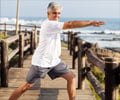Can exercise slow down sarcopenia? Yes, regular practice of exercise during middle age can slow the progression of sarcopenia and reduce aging-related muscle loss.

Highlighting the Benefits of Exercising on the Risk of Sarcopenia
The condition significantly impacts their quality of life, and thus, it is crucial to have strategies that prevent its onset. By establishing the association between sarcopenia and exercise, researchers think they might move one step closer to reducing risk factors of sarcopenia in older Japanese adults.‘Including exercise habits during adolescence and middle age may lower the risk of ‘sarcopenia’ or age-related muscle weakening.’





They assessed the exercise habits of 1,607 community-dwelling Japanese adults comprising 679 males and 928 females aged 65–84, as part of the “Bunkyo Health Study”. The participants underwent a complete health examination, including measurements of skeletal muscle index, handgrip strength, and gait speed.They were further divided into four groups based on their exercise habits in adolescence and older age: no exercise in either period, exercise only in adolescence, exercise only in older age, and exercise in both periods.
Multivariate-adjusted logistic regression models were used to estimate the odds ratios (ORs) for the prevalence of sarcopenia in each group. Low muscle performance was defined as low muscle strength and/or low gait speed.
Of the total participants, 6.6% of the men and 1.7% of the women had sarcopenia. Low muscle mass was prevalent in 14.3% of the men and 5.2% of the women, while low muscle performance was recorded in 25.6% of the men and 19.6% of the women.
In men, the ORs for sarcopenia, low muscle mass, and low muscle performance were significantly lower in the group that exercised during adolescence and older age. In contrast, in women, the OR for low muscle performance was significantly lower in those who exercised during their adolescence and older age.
It’s Time to Push More Young People in Japan Toward Healthier Lifestyle
The findings indicated that older men who exercised in their adolescence and older age were at a lower risk of sarcopenia and had better muscle mass and muscle performance. In contrast, older women with exercise habits during these phases of their lives were at a lower risk of poor muscle performance.Advertisement
It is concerning that in Japan, the rate of exercise implementation is highest during junior high school and then rapidly decreases with age.
Advertisement
Source-Eurekalert















